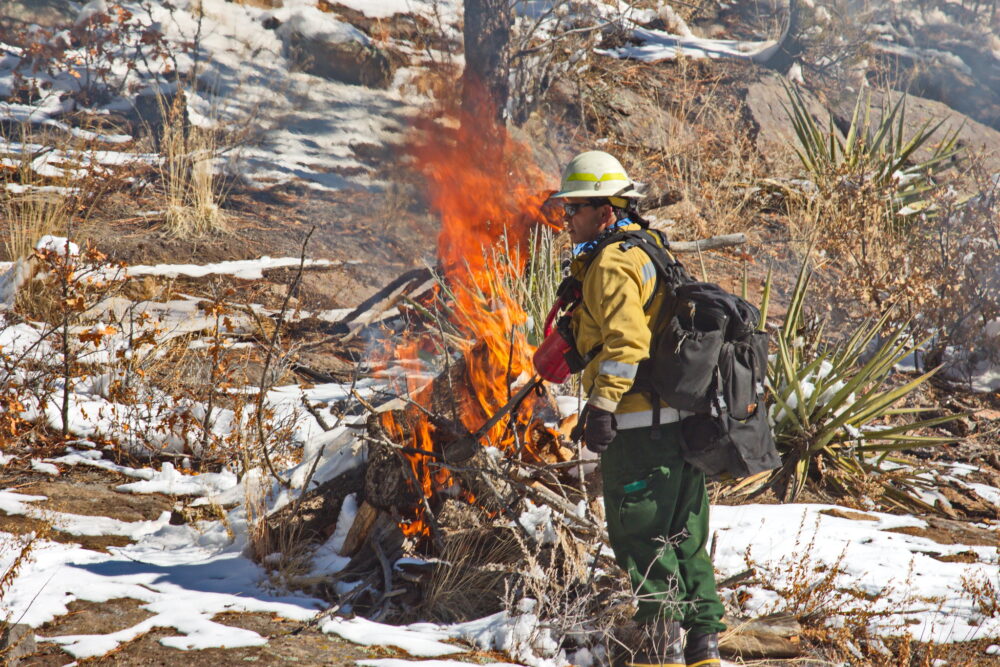
By Siobhan Niklasson, based on a conversation with Bob Parmenter of the Valles Caldera
The forests of the American West look much different today from how they looked 150 years ago. Around that time, a handful of large and destructive fires in the United States convinced land managers and the public that fires should be stopped as soon as possible in order to protect natural resources.
However, the decision to suppress wildfires had unintended consequences. Historically, frequent fires in ponderosa pine forest removed excess growth and kept the landscape open. Historical ponderosa pine forests were described as open and park-like and it was said that you could ride a horse through the forest for miles without hitting your head on a branch. This 2011 article from The Durango Herald gives some insight into the history of the forests of the Jemez Mountains and how fire suppression changed them.
Without fire to clear the landscape, many more trees were able to take root, increasing the tree density from around 40 – 60 trees per acre to 1,000 – 2,000 trees per acre in some cases. It’s painful just to think about trying to ride a horse through such a dense forest!

So many trees in the forest meant that each tree had to compete for water and nutrients with all its neighbors, surface water running in streams was reduced, sunlight was largely blocked from the ground level, leading to a dearth of grasses and other understory plants, and animals that depended on these small plants for grazing were squeezed out. Crucially, for fires, the increase in fuel in the forest turned what would once have been healthy ground fires into raging infernos that could wipe out an entire forest, and get so hot that the soil was sterilized.
Today, we have a better understanding of the importance of fire in our forest ecosystems. But the 150 years of fire suppression policy left a legacy of overgrown forests that must be returned to a healthy state, both to restore healthy ecosystems, and to reduce the risk of severe megafires.
In the Jemez Mountains, agencies have joined forces in a collaborative forest landscape restoration program to undertake this work. The first step is to thin the forest using mechanical means or cutting by hand to reduce the density from 1,000+ trees per acre to about 100 trees per acre. This means potentially cutting out 90% of the trees in the area! Once the trees are cut, they can either be removed and used for wood products, or they can piled and burned. This work is expected to be completed in the southwestern Jemez Mountains within another two to three years.
Once the forests are thinned, natural mortality will further reduce the number of surviving trees. The idea is that after another 100 – 200 years, we will end up with a mature forest with about 40 – 60 trees per acre.
With the first thinning completed, natural and prescribed fire can be used to manage the forest. It’s much cheaper and safer to manage fire in a thinned forest than it is to bring in helicopters and air crews to battle high-intensity fires that threaten lives and neighborhoods. For example, the 2011 Las Conchas fire burned over 150,000 acres, and cost almost $50 million to control.

In 2019, a lightning strike in the Valles Caldera started a low-intensity ground fire that burned through thinned forests. Firefighters saw an opportunity to use this fire to maintain some forested areas that needed to be burned. With the cooperation of local residents, they managed to safely allow the fire to burn right up to the boundary between the preserve and the Sulfur Flats neighborhood.
For the trees, thinning makes it easier for each individual tree to secure the resources (water and nutrients) it needs to survive. This should help the trees be more resilient to rising temperatures due to climate change.
A tree can live for several hundred years. Even if we are able to reverse the trend in our greenhouse gas emissions by 2050, we can expect temperatures to keep rising for another 50 years after that, and it could be an additional 50 years before temperatures cool off again.
So while that timescale of around 150 years is a long time in human terms, it means that the trees that are living now could potentially see the other side of the climate change curve, if we can help them survive fires and beetle infestations now.
Next time you’re out, see if you can find signs of forest thinning and prescribed burns. This is important work that’s keeping our forest ecosystems healthy for everything, including us, that depends on them.
Learn more about the history of forest fire suppression here.
